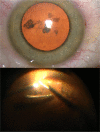Standardized Classification of Mechanical Ocular Injuries: Efficacy and Shortfalls
- PMID: 35005522
- PMCID: PMC8697050
- DOI: 10.14744/bej.2021.01488
Standardized Classification of Mechanical Ocular Injuries: Efficacy and Shortfalls
Abstract
Objectives: The aim of this study was to examine the efficacy and the shortfalls of the Birmingham Eye Trauma Terminology classification system for ocular trauma in predicting the visual outcome.
Methods: The records of 256 eyes of 246 patients with a diagnosis of mechanical ocular trauma admitted to the Osman Gazi University Hospital ophthalmology department between 1995 and 2000 were retrospectively reviewed. The zone, type, grade, and pupil status of the injuries were determined according to the Birmingham classification system. Injuries with a good prognosis were defined as injuries that resulted in vision of equal to or better than counting fingers at 1 meter. Fischer's exact test was used to determine the statistical significance of relationships between the final visual acuity and the initial clinical findings.
Results: Open eye injuries restricted to zone I, those with no afferent pupillary defect, and those graded as 3 or better or classed as type B were significantly associated with a better visual outcome (p<0.05). Open eye injuries that extended to zone III, had an afferent pupillary defect, or were graded as 4 or worse were significantly associated with a poorer visual outcome (p<0.05). Closed eye injuries classified as type B or grade 4 were significantly associated with a poor visual outcome (p<0.05).
Conclusion: The Birmingham classification system for mechanical ocular trauma offers a standardized method for both open and closed eye injuries, however, adding subclasses to type C (injuries with foreign body involvement) could enhance the classification method and help to understand the influence of foreign body properties and sizes on the outcome.
Keywords: Birmingham classification; classification; mechanical trauma; ocular trauma.
Copyright © 2021 by Beyoglu Eye Training and Research Hospital.
Figures
Similar articles
-
Prognostic factors in open eye injury managed with vitrectomy: retrospective study.Croat Med J. 2004 Jun;45(3):299-303. Croat Med J. 2004. PMID: 15185422
-
A system for classifying mechanical injuries of the eye (globe). The Ocular Trauma Classification Group.Am J Ophthalmol. 1997 Jun;123(6):820-31. doi: 10.1016/s0002-9394(14)71132-8. Am J Ophthalmol. 1997. PMID: 9535627
-
A five-year retrospective study of the epidemiological characteristics and visual outcomes of patients hospitalized for ocular trauma in a Mediterranean area.BMC Ophthalmol. 2008 Apr 22;8:6. doi: 10.1186/1471-2415-8-6. BMC Ophthalmol. 2008. PMID: 18430231 Free PMC article.
-
The prognostic significance of a system for classifying mechanical injuries of the eye (globe) in open-globe injuries.J Trauma. 2003 Apr;54(4):750-4. doi: 10.1097/01.TA.0000047053.53821.C8. J Trauma. 2003. PMID: 12707539
-
The epidemiology of Open Globe Injuries presenting to a tertiary referral eye hospital in Australia.Injury. 2017 Jul;48(7):1348-1354. doi: 10.1016/j.injury.2017.04.035. Epub 2017 Apr 18. Injury. 2017. PMID: 28438416 Review.
Cited by
-
Epidemiological and clinical findings of ocular trauma in a public hospital in Türkiye.Ulus Travma Acil Cerrahi Derg. 2025 Feb;31(2):178-188. doi: 10.14744/tjtes.2025.77137. Ulus Travma Acil Cerrahi Derg. 2025. PMID: 39963917 Free PMC article.
-
Ocular trauma among patients attending a tertiary teaching hospital in Zimbabwe.PLoS One. 2023 Oct 4;18(10):e0292392. doi: 10.1371/journal.pone.0292392. eCollection 2023. PLoS One. 2023. PMID: 37792744 Free PMC article.
-
Case report: Scleromalacia caused by rheumatoid arthritis combined with high intraocular pressure, first discovered due to ocular trauma.Front Med (Lausanne). 2025 Jan 30;11:1504807. doi: 10.3389/fmed.2024.1504807. eCollection 2024. Front Med (Lausanne). 2025. PMID: 39949387 Free PMC article.
-
Post-traumatic visual sequelae from a forensic medicine perspective: A retrospective analysis of 10 years of data.Ulus Travma Acil Cerrahi Derg. 2025 Jul;31(7):682-690. doi: 10.14744/tjtes.2025.54778. Ulus Travma Acil Cerrahi Derg. 2025. PMID: 40629737 Free PMC article.
References
-
- Kuhn F, Morris R, Witherspoon CD, Mester V. The Birmingham Eye Trauma Terminology system (BETT). J Fr Ophtalmol. 2004;27:206–10. - PubMed
-
- Kuhn F, Morris R, Witherspoon CD, Heimann K, Jeffers JB, Treister G. A standardized classification of ocular trauma. Graefes Arch Clin Exp Ophthalmol. 1996;234:399–403. - PubMed
-
- Gilbert CM, Soong HK, Hirst LW. A two-year prospective study of penetrating ocular trauma at the Wilmer Ophthalmological Institute. Ann Ophthalmol. 1987;19:104–6. - PubMed
-
- Ramsay RC, Cantrill HL, Knobloch WH. Vitrectomy for double penetrating ocular injuries. Am J Ophthalmol. 1985;100:586–9. - PubMed
-
- De Juan E, Jr, Sternberg P, Jr, Michels RG. Penetrating ocular injuries. Types of injuries and visual results. Ophthalmology. 1983;90:1318–22. - PubMed
LinkOut - more resources
Full Text Sources


